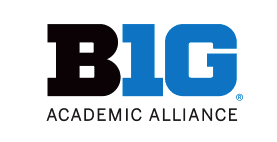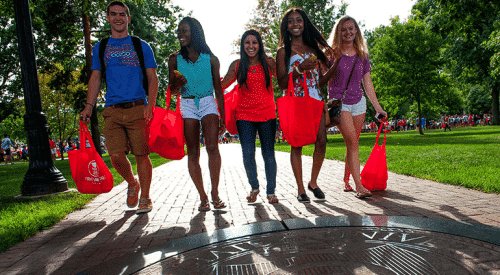Dr. Berger: Well, Barb, I get the opportunity to speak to people in education all over the world that are doing fascinating things. One of the components I find compelling is the way in which we’re looking at the future of education. We are changing the way we approach our interaction with students and the ways in which we look at funding. When I heard about the Big Ten Academic Alliance, I thought we should have more people who know about it, especially when looking at the size and scope of what you’re doing.
I know elevator pitches are elevator pitches, but I’d love to hear the “soup to nuts” on the Big Ten Academic Alliance for those who may not know about it in the realm of research and the impact you’re having on global education.
Barbara McFadden Allen: Oh, great. Yes. Well, since 1958, the member universities at the Big Ten Athletic Conference have collaborated on the academic and research side of the house in the same way that they work together on the athletics side. We just happen to know more about athletics because it garners more public attention than academics. For the past 50 years, these institutions have shared research projects. One of the first things they did together was the buying of a big, expensive telescope together in South America. By leveraging all of their investment, they could buy a very large, expensive piece of equipment. That continues to this day. We share labs, facilities, and services in that way. We also share study abroad programs, course development across the campuses, leadership development, and other offerings. Anything that can be combined or leveraged, where you can drive some efficiency, these institutions work together, and our office helps that become accomplished.
DB: Talk about the scope. We had conservation off air about the sheer numbers involved in your interactions. It’s not about the importance of those numbers, but rather it speaks to the amount of work being done. Talk a little bit about the numbers, because I think it may wake a lot of people up and shed some light on what you’re doing.
BA: Yeah. It is astonishing. These institutions conduct $11 billion in funded research each year. It’s more than the Ivy League and the University of California system combined. Every single year the federal government, state governments, and corporations are investing in these campuses to fuel the development of new knowledge and discovery, so that’s quite amazing. We teach 600,000 students, and we have physical plants in 11 states. It’s an enormous enterprise.
DB: It’s incredible. I know you’ve been there some years but if I were to ask you to compare when you first took office, so to speak, to where you are now in 2016, what would be your take? What have you learned about the industry that gives you that unique perspective we can learn from?
BA: The institutions like any group that’s working together, have become more sophisticated about their collaboration over the years. When I started; our portfolio was much, much smaller because it’s a complicated thing to work across institutions. For instance, there is research in the corporate sector that shows 60% of all corporate partnerships fail. So, you can imagine a group of 15 research universities or 14 research universities trying to connect; you can have a lot of failure rate. Over the last 25 years, the institutions have become much more sophisticated about the ways they coordinate and collaborate. They’ve gone from really no collaborative procurement, for example, which is an area you think would be quite simple to manage, to where we now coordinate something like $100 million in procurement for campuses every year. It could be as simple as buying test tubes, for instance, it makes perfectly good sense, but you have to have systems in place.
I think they’ve gotten more sophisticated about back-end administrative kinds of collaboration. It sets the stage for what I think is the most exciting possible development, and that is thinking about that $11 billion in funded research and how we connect researchers. For example, how do we connect researchers at Michigan who are unlocking the secrets of deep space to faculty in Illinois so that they can do their work smarter, faster, and better? Allowing graduate students on campuses to have access to the best opportunity for research that trickles down to the undergraduates, who then get a chance to work side-by-side with Nobel Laureates.
DB: Yes, incredible opportunities. You know, there are a lot of big questions that people are trying to solve in higher education that have far-reaching implications for K-12. And then study abroad, we’re talking about education on a global scale. When you look at the research these universities are conducting, do you see shifts in the research and the types of questions trying to be answered? Do they have a relation to the things we might see in popular media? When we talk about engagement, how do we maintain engagement with students on college campuses? How do we know that student will stay for the full four years at a four-year university? There are a lot of big economically based questions that ask how we can keep universities running at the same clip that they’ve become accustomed? Are you seeing that from the research side, the funding side or in the questions by people who are coming to you to connect with these universities?
BA: That’s an insightful question. I would answer that in two ways. I heard a couple of things embedded in what you asked. The first is how our universities can have a direct positive impact on the quality of life and the communities where we find ourselves, whether it’s in a state or the nation or the world. In our universities, there are two specific examples. We’ve teamed up with the Ivy League to study traumatic brain injury in athletes. Brain injury a very significant public health issue right now. It’s certainly gotten a lot of attention.
In our group of universities, we have 20,000 student athletes. We have a population that needs to be protected. We want the best outcome for our student-athletes, so we want to be sure to have sideline protocol that’s protective of them and responsive to them. At the same time, we have clinicians and researchers across our campuses that can help us think about how to treat traumatic brain injury no matter how it is manifested. One way we can help is to direct the research of our institutions toward a problem that is directly relevant to our students; in this case, the student-athlete.
 Another example is we’re partnering with the public health agencies in the 11 states where we find our universities. Now we have money support from the Kellogg Foundation and the Robert Wood Johnson Foundation to study health inequities in the region. Why are health outcomes different for people in different socioeconomic strata, for example, or why are health outcomes worse for people that live in a particular ZIP code? Those are really interesting research questions, and if we can delve into those using our university research, we can help shape public policy to improve health outcomes for children and others. Those are ways the university can be more responsive immediately.
Another example is we’re partnering with the public health agencies in the 11 states where we find our universities. Now we have money support from the Kellogg Foundation and the Robert Wood Johnson Foundation to study health inequities in the region. Why are health outcomes different for people in different socioeconomic strata, for example, or why are health outcomes worse for people that live in a particular ZIP code? Those are really interesting research questions, and if we can delve into those using our university research, we can help shape public policy to improve health outcomes for children and others. Those are ways the university can be more responsive immediately.
And then to your very good question about how do you take what you know about research as a research university and train that to the very people you serve? So how do we work with our researchers to better understand student outcomes and student performance? It’s not because this consortium is pushing this, but, virtually every one of our Big Ten universities is very interested in the student life experience and studying why some students get out in four years, and some take seven years. We know the best way to drag down the cost of higher education for a family is to get out as quickly as possible, right? Get your degree in four years. It’s the most cost-effective way to do it. Why don’t all students do that and what can we do to shorten their time to degree, for example?
Colleges of education and others do partner with the administration on our campuses to help address these questions. One of the beautiful things about this kind of collaboration across institutions is they can set in place infrastructure that helps us tee-up questions and addresses them faster than if we were just a single system trying to solve problems ourselves. We can do a lot of benchmarking across our campuses much more quickly and readily.
DB: You can go in so many different directions, and I think it’s interesting when we can flip it on the very people we’re interfacing with on the campuses across the Big Ten and beyond, to your point about the Ivy League collaboration. So, Barb, where can people go to find more information regarding research projects? Frankly, companies and entities in this industry may wish to engage with the Big Ten Academic Alliance, where should they go?
BA: The easiest thing to do is go to our website, www.btaa.org and you will see right on the front page; we have some highlights of research projects, plus links to all the administrative and other projects underway, including links to the staff. We’re always interested in understanding how we can do our work better and help our universities achieve their mission to teach, conduct research and engage our communities.
DB: Well, you’re doing amazing work. I can’t imagine what it’s like to be the Grand Central Station to all that’s going on with the universities. It’s a job well done and very needed both on the education side of it, but also from a parent’s perspective. It’s nice to see this entire actively taking place in a thoughtful manner. We want to thank you, Barb, for your time.
Barbara McFadden Allen is the executive director of the Big Ten Academic Alliance, BTAA, formerly known as, the Committee on Institutional Cooperation (CIC), a position she has held since 1999. Founded in 1958, the BTAA supports inter-university cooperative efforts across fifteen research universities (the members of the Big Ten Athletic Conference and the University of Chicago). She serves on the Steering Committee of the Global Midwest Initiative of the Chicago Council on Global Affairs and the boards of the Association of Collaborative Leadership (where she is currently Vice President) and the National Consortium for Continuous Improvement in Higher Education. She received her A.B. and her M.L.S. from the University of Missouri-Columbia.
Brought to you by Schoold



